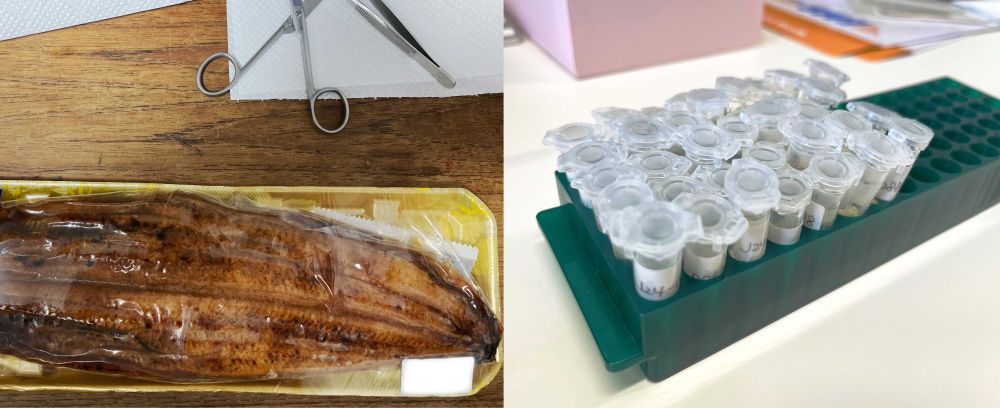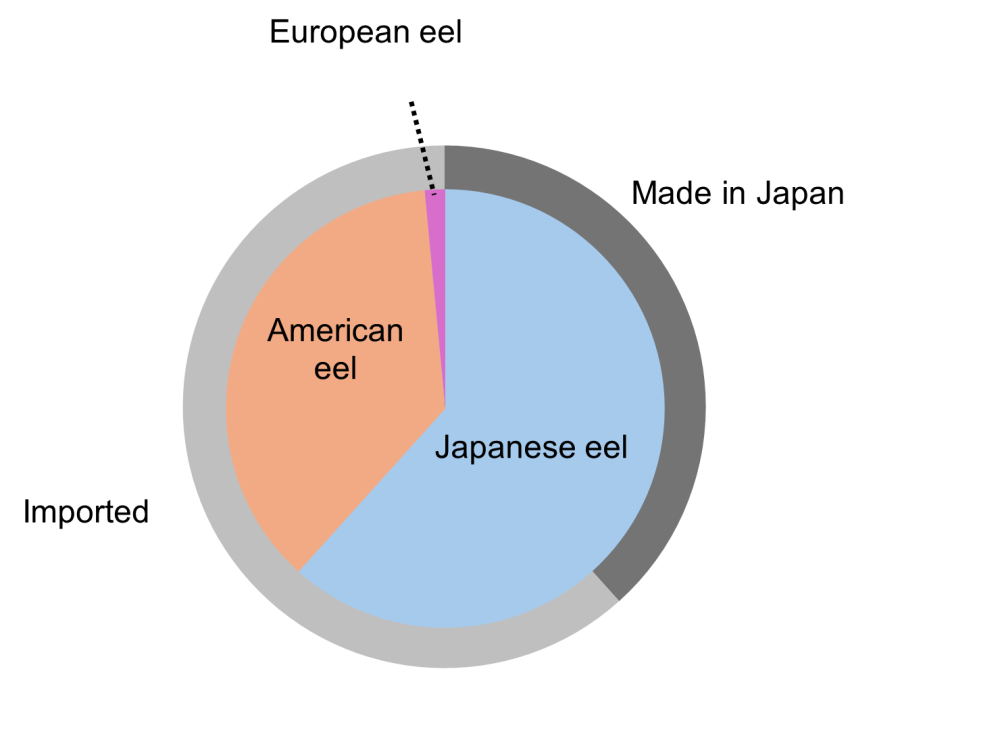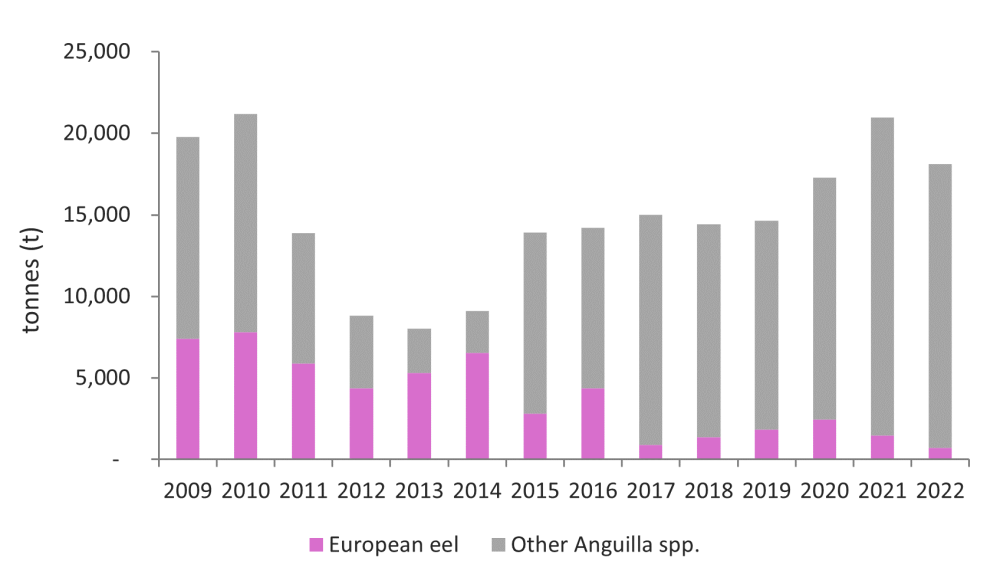2025.06.24
News
Nearly 40% of Grilled Eel Products in Japanese Retail Market Identified as American Eel
Research led by Hiromi Shiraishi, researcher at Chuo University, has revealed that, in addition to Japanese Eel (Anguilla japonica), American Eel (Anguilla rostrata) is now widely distributed in processed eel products sold at retail stores across Japan. While eel farming in Japan relies primarily on Japanese Eel, two-thirds of eel consumption in the country depends on imports of live adult eels and eel products, which include several species of anguillid eels. As the world’s largest importer and consumer of eel, Japan is in a position to contribute to the sustainable use of anguillids beyond Japanese eel.
Key Findings of the Study
● With the CITES listing of the European Eel (Anguilla anguilla) and the decline in catches of Japanese Eel, the demand for live eel fry (glass eels) for aquaculture has shifted to other eel species. Although Southeast Asia once served as a major source of eel fry, recent years have seen a sharp increase in demand for American Eel.
● In 2024, a total of 134 grilled eel (kabayaki) products were purchased from retailers in several cities in Japan (Hakodate, Sendai, Tokyo, Osaka, Okayama, Fukuoka, and Kagoshima) for species identification.
● Among 133 successfully DNA-barcoding identified samples, Japanese eels were the most common species (accounting for 61.7%, 82 samples), followed by American eels (accounting for 36.8%, 49 samples). Two samples were also identified as European Eel.
● A clear difference in species composition was observed between domestically produced and imported eel products. All domestically produced eel products were identified as Japanese eel, whereas American eel was the most frequently identified species in imported products—all of which were from China.
● The presence of European eels in the Japanese market was found to be minimal, suggesting limited direct involvement in the illegal trade of the species.
● The results of this study have been peer-reviewed and published in the international academic journal Fisheries Science on 13 June 2025.
1. Background of the Study
There are currently 19 species/subspecies of freshwater eels in the genus Anguilla. These species face a range of threats including changes in oceanic currents and/or climatic conditions, barriers to migration, loss or degradation of freshwater habitat, disease, pollution, and unsustainable exploitation and trade. Stocks of eel species most notably those in temperate Northern Hemisphere regions, have exhibited declines. These include the European Eel, currently listed as Critically Endangered (CR) on the IUCN Red List of Threatened Species, as well as the Japanese Eel and American Eel, which are classified as Endangered (EN).
As artificial breeding of Anguilla spp. is not yet commercially viable, all eels consumed today are wild origin, primarily juvenile glass eels (eel fry) caught and raised in aquaculture. Eel farming is most active in East Asia (China, Japan, South Korea and Taiwan), with Hong Kong being an important trade hub for the international glass eel trade.
Following the CITES-listing of the European Eel in 2007, which came into effect in 2009, and the low catches of Japanese eels in early 2010s, demand for live eel fry of other species increased. After Southeast Asia temporarily emerged as a key source of supply, demand has increasingly concentrated on the American eel. Meanwhile, illegal trade in European eels, specifically glass eels, has persisted on a large scale. These illegally traded glass eels are suspected to be laundered into aquaculture outside Europe and may re-enter global markets under the guise of other species.
The limited morphological distinctions between certain eel species, even in whole specimens, make genetic analysis indispensable, especially for processed products. In addition, the lack of species-specific trade codes obscures trade patterns and consumption trends. As the world's leading consumer and importer of eels, Japan plays a crucial role in the sustainability of eel populations. However, detailed studies on the species composition of eels in the Japanese market remain conspicuously absent.
2. Research Content
A total of 134 eel products (kabayaki) were purchased from retailers in several cities in Japan (Tokyo, Osaka, Fukuoka, Okayama, Kagoshima, Sendai, Hakodate) from January to February and in July 2024. All samples were collected from retailers including supermarkets and department stores for this study, because 88% of eels consumed in Japan are sold via retailers based on sales value according to the final report on the commissioned by the Fisheries Agency of Japan.
Total DNA was extracted for DNA barcoding, amplified using PCR, and the cytochrome b gene was sequenced to identify species. The results were compared with the data on glass eel input for farming and aquaculture production in Japan and China, Japan's import statistics for live and processed eels, and CITES trade data for European Eel.

Figure 1. Example of processed eel products (left) and storage container for collected tissue samples (right)
Of the total 133 samples where species identification was successfully performed, the Japanese eel was the most frequently identified species, accounting for 61.7% of eel products with 82 samples, followed by American eels (36.8%, 49 samples) and European eels (1.5%, two samples). All domestically produced eel products were identified as Japanese eels. For the imported products, all of which were from China, American eel was the most frequently identified species.
According to the data released along with the 16th meeting of the Informal Consultation in 2023, Japanese eels accounted for almost 100% of glass eel input for farming in Japan in recent years. The same data suggested Japanese eels and American eels accounted for more than 90% of glass eel input for farming in China from the 2018-2019 fishing season to the 2022-2023 fishing season. The species composition of eel products corresponded to live eel fry input data for farming in Japan and China.

Figure 2. The species composition of eel products obtained in the Japanese market. The dark and light grey circles indicate eel products made in and outside Japan, respectively.
Japan was once considered one of the largest markets for European eel consumption, but the current study suggests that consumption is now minimal. This study indicated a clear shift in the secondary dominant species, transitioning from European eels to American eels, with only two samples of European eels detected. The recent species identification of eel samples in Europe, North America and Singapore, suggest that the growing dominance of American eels in the global eel consumption market in recent years — a trend that has now also been confirmed in Japan through this study. The recent sharp increase in harvesting and trade of glass eels has raised concerns about IUU fishing and illegal trade in American eel range states1.
CITES trade data and Customs data indicated that European eels were estimated to account for 72.1% of the total prepared eel imports from China around in 2014. The proportion of European eels seem to have substantially declined over the years to as low as 3.9% in 2022. The low frequency of the species in the study (1.5%) aligned to the expected frequency of European eels based on Japan Customs' import data and CITES trade data. Although this is based on a snapshot survey, it is unlikely that European eels have been bypassing the CITES regulation and illegally entering the Japanese market in large quantities.

Figure 3. Prepared eel imports into Japan from 2009 to 2022, reported in t . Purple represents the estimated volume of European eel (Anguilla anguilla) in prepared eel (reported as meat in the CITES trade database), while gray represents other Anguilla spp.
Previous research has highlighted the large scale of illegal trade in European eels. However, the consumption scale and patterns of European eels grown from smuggled glass eels remain relatively unclear, creating a gap in the understanding of the full scope of this issue. As with the necessity to monitor the species of eels sold in the Japanese market, further research on eel consumption would be needed in other lesser-known countries and regions, including China and South Korea.
1 In response to a surge in illegal activities, elver fishing licences were not issued for the 2024 season in Canada (https://gazette.gc.ca/rp-pr/p1/2024/2024-06-29/html/reg6-eng.html). Additionally, a UN Security Council briefing raised concerns about links between eel trafficking in Haiti and drug trafficking and money laundering (https://www.unodc.org/unodc/en/speeches/2025/220125-un-security-council-briefing-haiti.html).
3. Outcomes of the Study and Future Directions
This study demonstrated that the majority of eels currently consumed in Japan are Japanese eels and American eels, with European eels being rarely encountered. The increasing prevalence of American eels in global markets is now observed in Japan, historically a key driver of global eel demand. Ongoing inspections remain necessary to prevent the importation of European eels farmed using glass eels illegally smuggled from the EU. As the world’s largest importer and consumer of eel products, Japan is in a position to contribute to the sustainable use of anguillids beyond Japanese eel.
4. Acknowledgments
This study was funded by Chuo University, the Society for the Promotion of Science (JSPS) KAKENHI Grant Number JP22H00371, and National Science and Technology Council of Taiwan NSTC 111-2313-B-002-016-MY3.
5. Paper Information
● Title: Eel consumption in Japan: insights from genetic species identification and trade data.
● Authors: Hiromi Shiraishi (Chuo University), Yu-San Han (National Taiwan University), Kenzo Kaifu (Chuo University)
● Published in Fisheries Science
● Publication Date: 13 June 2025
● Link: https://link.springer.com/article/10.1007/s12562-025-01894-2
6. Contact Information
For research-related inquiries:
Hiromi Shiraishi, Faculty of Law, Chuo University
Email: hshiraishi734★g.chuo-u.ac.jp
Please replace★with @ when writing an email.
For media inquiries:
Chuo University Public Relations Office
Email: kk-grp★g.chuo-u.ac.jp
Please replace★with @ when writing an email.
